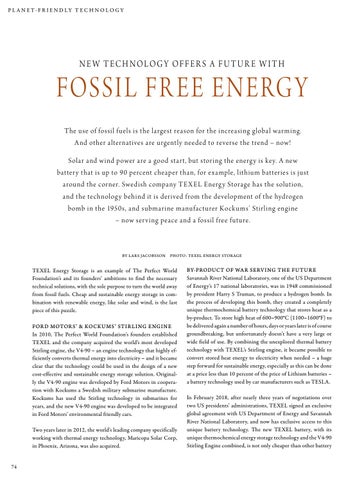P L A N E T- F R I E N D LY T E C H N O L O G Y
N E W TECH NOLOGY OFFER S A FU T U R E W IT H
FOSSIL FR EE ENERGY The use of fossi l f uels is t he la rgest reason for t he i ncreasi ng globa l wa r m i ng. A nd ot her a lter natives a re urgent ly needed to reverse t he trend – now! Sola r a nd w i nd power a re a good sta r t, but stor i ng t he energ y is key. A new batter y t hat is up to 90 percent cheaper t ha n, for exa mple, l it h iu m batter ies is just a round t he cor ner. Swed ish compa ny T E X EL Energ y Storage has t he solution, a nd t he tech nolog y beh i nd it is der ived f rom t he development of t he hyd rogen bomb i n t he 1950s, a nd subma r i ne ma nu fact urer Kocku ms’ Stirl i ng eng i ne – now ser v i ng peace a nd a fossi l f ree f ut ure.
BY LARS JACOBSSON
PHOTO: TEXEL ENERGY STORAGE
TEXEL Energy Storage is an example of The Perfect World Foundation’s and its founders’ ambitions to find the necessary technical solutions, with the sole purpose to turn the world away from fossil fuels. Cheap and sustainable energy storage in combination with renewable energy, like solar and wind, is the last piece of this puzzle. FOR D MOTOR S’ & KOCKUMS’ STIR LI NG ENGI NE In 2010, The Perfect World Foundation’s founders established TEXEL and the company acquired the world’s most developed Stirling engine, the V4-90 – an engine technology that highly efficiently converts thermal energy into electricity – and it became clear that the technology could be used in the design of a new cost-effective and sustainable energy storage solution. Originally the V4-90 engine was developed by Ford Motors in cooperation with Kockums a Swedish military submarine manufacture. Kockums has used the Stirling technology in submarines for years, and the new V4-90 engine was developed to be integrated in Ford Motors’ environmental friendly cars.
Two years later in 2012, the world’s leading company specifically working with thermal energy technology, Maricopa Solar Corp, in Phoenix, Arizona, was also acquired. 74
BY-PRODUCT OF WA R SERV I NG TH E FUTU R E Savannah River National Laboratory, one of the US Department of Energy’s 17 national laboratories, was in 1948 commissioned by president Harry S Truman, to produce a hydrogen bomb. In the process of developing this bomb, they created a completely unique thermochemical battery technology that stores heat as a by-product. To store high heat of 600–900°C (1100–1600°F) to be delivered again a number of hours, days or years later is of course groundbreaking, but unfortunately doesn’t have a very large or wide field of use. By combining the unexplored thermal battery technology with TEXEL’s Stirling engine, it became possible to convert stored heat energy to electricity when needed – a huge step forward for sustainable energy, especially as this can be done at a price less than 10 percent of the price of Lithium batteries – a battery technology used by car manufacturers such as TESLA.
In February 2018, after nearly three years of negotiations over two US presidents’ administrations, TEXEL signed an exclusive global agreement with US Department of Energy and Savannah River National Laboratory, and now has exclusive access to this unique battery technology. The new TEXEL battery, with its unique thermochemical energy storage technology and the V4-90 Stirling Engine combined, is not only cheaper than other battery


































